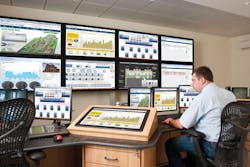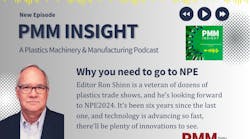Plastics processors that want to conserve energy first need to know how and where they are using it.
“The key thing for energy-effectiveness is knowing what each of your machines is producing and consuming, as far as energy is concerned, and then looking at ways to optimize that power usage,” said Michael Day, Siemens market development manager. “But first, you have to know what your energy usage is before you optimize it.”
Related stories: Harbec succeeds in carbon-neutral quest; Solar, battery storage bring savings to Iowa blow molder; Pinpointing energy-guzzlers is key to saving money
Siemens is one of a number of companies that offer a variety of energy-management hardware and software that can help. Centrica Business Solutions is another provider. Other companies, such as Fluke, supply sensors to determine the energy-efficiency of particular machines.
Siemens
Siemens’ portfolio of equipment includes its 3VA series of circuit breakers that can monitor the energy used by a single piece of machinery.
“It allows you to monitor energy being used by a large piece of equipment,” said Austin Cheek, a solutions business developer for Siemens. “What you can do once you have monitored it for weeks, months or years, you can compare that analytically over time. You can compare current energy consumption to historical consumption, and what you start to see is trends.”
For example, a user can see if a specific piece of equipment draws more power as it ages.
If powering older equipment is growing increasingly expensive, it might be more cost-effective to replace the equipment, he said. The 3VA circuit breakers also can help identify specific machines that consume more power than similar equipment, which may indicate a need for service or replacement.
But individual machines are only part of the equation. Siemens encourages a holistic approach to energy management, monitoring energy use throughout an entire facility, Day said.
The company’s 3WL circuit breakers are designed to serve an entire small factory or a section of a large factory. They monitor energy use and protect against damage or fire caused by short circuits, ground faults or overload faults.
For companies that want to spend less or don’t require new circuit breakers, Siemens offers the PAC series of power meters, ranging from the PAC2200 for basic energy metering to the PAC4200, which offers alarm options, greater accuracy with revenue metering, and more detailed information about power quality, data and waveform logs.
“Power quality can be very complex, but suffice it to say that if your power quality is not in check, a significant portion of your energy bill every month is wasted energy, and you can also be damaging your mechanical equipment downstream pretty severely in the long run,” Cheek said.
Siemens equipment can communicate via Wi-Fi, cellular data or Ethernet, and Siemens PowerManager software makes the data accessible via personal computer, tablet or cell phone. The equipment also can communicate with Siemens’ WinPM.Net power-monitoring software or third-party software that can compile and analyze data from metering and monitoring equipment throughout a factory.
“We’ve got several software suites, and we work with an end user to determine what is going to meet their specific needs best,” Cheek said.
Siemens recently introduced its ninth version of the WinPM.Net software, which allows users to process, analyze, store and share energy-usage and power-quality data across an entire plant or multiple locations. It helps identify areas of high energy consumption. Users can set alarms to warn them when energy usage or power quality is outside of parameters. Graphical timelines assist in analyzing events and alarms and their potential impacts on operations. Analysis tools calculate, model, forecast and track energy performance.
WinPM.Net software can communicate not only with Siemens hardware but with most kinds of third-party hardware and processing equipment that communicate using open-source protocols, including injection molding machines, blow molding machines and extruders.
Information collected by WinPM.Net can be accessed from any workstation or smart device locally or around the world using standard web browsers. Key uses include real-time energy monitoring, alarm management, system status and an extensive array of reports. Information can be presented on a dashboard or through diagrams or tables, and real-time data can be displayed through a graphical format.
The software can be used for cost allocation and sub-billing, such as allowing plastics processors to determine the energy costs associated with producing certain parts.
The software can help companies monitor their power use in real time and shave energy consumption during peak demand periods.
Siemens hardware and software also can be combined with Siemens MindSphere, a cloud-based IoT open-operating system that connects plants, systems, and machines, enabling companies to access their data with advanced analytics. MindSphere works with all popular web browsers and can be used to compile data from multiple locations around the world.
While WinPM.Net collects data on a client’s server, MindSphere collects and analyzes data in the cloud.
Centrica Business Solutions
A hardware and software package from Centrica that monitors energy consumption is designed to help clients reduce energy costs, proactively manage use and improve operational efficiency.
The Energy Insight system monitors the energy consumption of individual pieces of equipment. Centrica representatives work with clients to decide whether to monitor all the equipment or specific pieces of equipment in a facility, or even multiple sites. Many customers opt to focus on the equipment that uses the most energy, like injection molding machines, extruders, blow molding machines or compressors.
The Energy Insight hardware includes self-powered, wireless, non-intrusive sensors that collect real-time energy data and analytics. The system also can collect information from gas, water and air-flow meters.
Information from the sensors and meters is fed into PowerRadar cloud-based software, which analyzes and displays it in real time on a personal computer, tablet or smartphone.
The PowerRadar dashboard displays historical, current and projected energy consumption. A screen analyzes data from specific circuits or devices to pinpoint energy waste and consumption irregularities that could indicate maintenance issues.
PowerRadar allows users to easily create alerts when energy thresholds are exceeded. The alerts can signal a potential maintenance issue, allow users to temporarily reduce energy consumption to avoid peak demand charges, or participate in demand-response programs with an electricity provider.
PowerRadar can export data to other software for analysis.
The system is just one offering from Centrica and sister company Direct Energy Business.
“Centrica Business Solutions and Direct Energy Business, we’ve positioned ourselves to have everything a customer needs for total energy management, which goes not only from buying energy strategically … but to then understand how each of their devices is operating and how they’re using their power on site, and how to take advantage of that information to improve their bottom line,” said Anthony Nole, the head of energy optimization in North America for Centrica Business Solutions.
Once a customer understands how it is using electricity, it can optimize its operations by reducing and better managing power consumption. Users can leverage the information to operate more efficiently. For example, they can reduce usage at peak times or lower their costs through negotiated purchase agreements of power. Insights from the data might also motivate them to install green power systems that use solar or combined heat and power systems.
Direct Energy is a North American retailer of electricity and gas services and is owned by the same parent company as Centrica Business Solutions. The companies partner to offer energy solutions to customers, including plastics processors.
“We see ourselves as adding the entire portfolio of energy-management services from end to end,” Nole said. “The Energy Insights piece is about understanding what you use and how you use it with higher resolution.”
Fluke
With its portfolio of power meters, Fluke can help plastics processors better understand energy costs and diagnose energy problems. Its product lines also include a device that detects leaks in compressed-air systems.
The company’s power loggers can detect situations in which poor power quality could cause energy inefficiencies, said Han Tran, a product manager for the company.
Fluke’s Connect software makes information collected by the loggers available via an internet connection.
“You can look at trending live data, if you would like, or download the data through the mobile app,” Tran said. “It depends on which model you are looking at.”
Companies can opt to either install a logger on each piece of equipment they want to monitor or install one logger to capture results from a branch circuit or an individual machine.
“We’ve had discussions about customers measuring the energy at one circuit branch, knowing that there are five machines there, and then taking that information and using it to price the parts they are making,” Tran said.
The loggers include the company’s 1730- and 1740-series units, which take into account the energy costs for producing a plastic part. The information could be beneficial in setting the price for parts as well as identifying areas of high energy consumption.
Also available are the company’s 1732 and 1734 three-phase electrical energy loggers, which are capable of identifying energy waste by measuring conditions such as voltage, current, power and power factor. The company’s 1736 and 1738 models provide information about harmonics, voltage dips and swells, and feature an oscilloscope function.
In addition to the energy loggers, Fluke offers its 438-II Power Quality and Motor Analyzer, which measures both the electrical and mechanical performance of electric motors. It analyzes not only three-phase power quality but also torque, efficiency and speed to determine system performance and detect overload conditions, eliminating the need for motor-load sensors, according to the company.
“If a plastics manufacturer has a ton of motors, which I assume they would, the 438-II is great because now you can connect up to a motor and see what kind of efficiency that motor is running at,” Tran said. “Are you 70 percent efficient or 90 percent efficient?”
The analyzer measures the efficiency of a motor while it is in use instead of having to remove it from the equipment to put it on a test bed.
This allows maintenance engineers to determine the motor’s in-service operating power compared with its rated power to determine, for example, if the motor is operating in overloaded condition. Alternatively, it might find that the power is oversized for the job it’s performing, which would mean that energy is being wasted and operating costs are higher than optimal, according to the company.
Fluke offers an online product selector to help customers select the power-quality and energy tools that best fit their needs. The selector asks a variety of questions about how a customer plans to use the tool and which measures they are planning to take. Based on the responses, the website will recommend one or more products to meet customers’ needs.
In addition to its energy-monitoring equipment, last year, Fluke released its ii900 Sonic Industrial Imager to pinpoint compressed-air leaks in minutes.
The average compressed-air system loses 20 percent to 30 percent of its air through leaks, according to Fluke, citing information from the Compressed Air and Gas Institute and the Department of Energy. However, locating those leaks has been a time-consuming and tedious process.
“A typical facility, like a typical plastics facility, if they don’t have a formal process in place for leak inspections and repairs, may leak up to 30 percent of their capacity,” said Javier Irazola, Fluke’s global product manager for industrial imaging. “What does that mean in dollars? It will depend, of course, on the size of the facility, but the ranges can go from a couple of thousand dollars per year to hundreds of thousands of dollars per year, if it is a big facility.”
Plastics processors rely extensively on compressed air for conveying systems, injection molding machines, blow molding machines, robotics and drying systems. If leaks cause a resin dryer to work ineffectively, it could lead to expensive production-quality problems and an increase in scrap, company officials said.
The ii900 Sonic Industrial Imager features an array of super-sensitive microphones that detect both sonic and ultrasonic sound waves. The imager triangulates the signal from each microphone to produce a sound-map image — a color map superimposed over the visible light image — showing the exact location of a leak. It is displayed on its 7-inch, LCD touch screen as a still image or real-time video that can be saved and exported for reporting purposes.
The ii900 can work even in the noisiest environments, and inspections can take place while a plant remains in operation, said Troy Skogmo, plastics engineering manager for Fluke. In a matter of hours, a team can inspect an entire plant during peak operation.
The ability to point the ii900 Sonic Industrial Imager at compressed-air leaks and capture photos and videos of the leaks helps with repairs and eliminates the need for workers to go up 20 to 30 feet above a factory floor to inspect air lines and tag leaks, Skogmo said.
Fixing compressed-air leaks not only can reduce a company’s utility bill, it also can reduce capital expenses by eliminating the need to replace an existing compressor with a larger model, according to Fluke.
Bruce Geiselman, senior staff reporter
Contact
Centrica Business Solutions, Iselin, N.J., 201-615-8252, www.centricabusinesssolutions.com
Fluke Corp., Everett, Wash., 425-347-6100, www.fluke.com
Siemens Industry Inc., Alpharetta, Ga., 800-333-7421, www.usa.siemens.com






